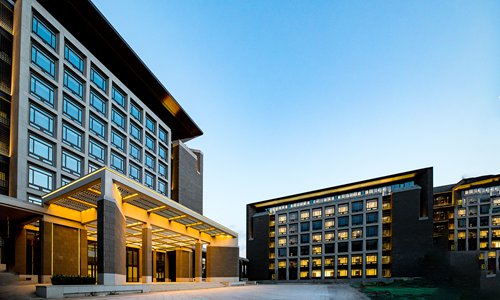Tongzhou sub-center and Xiongan to be capital’s two “wings”, showcasing China’s quality-driven model to world
China’s new sub-center plans to boost regional devt

The new office building of Beijing's municipal government and the Beijing Municipal Committee of the Communist Party of China in Tongzhou. Four key municipal organs of Beijing moved their offices to Tongzhou district on Friday. Photo: IC
"I'm expecting the [sub-center of] Tongzhou district to become Beijing's 'Pudong New Area' in the future," a resident surnamed Yu said in an excited voice.
Shanghai's Pudong New Area has witnessed an unprecedented economic boom since being set up as a new zone of national significance in 1990. The rapid economic rise has boosted Yu's confidence as she witnessed a flag-raising ceremony on Friday, which celebrated the four key municipal organs of Beijing moving their offices to Tongzhou district, making the eastern Beijing area a new municipal administration center of the capital.
This also marks a new era for the district, a 40-minute drive from downtown Beijing, to "be a green, smart, livable district without 'urban disease' that could become an example of the coordinated development of the Beijing-Tianjin-Hebei region," Sui Zhenjiang, vice mayor of Beijing, said at the press conference on Friday.
More importantly, the sub-center is expected to drive the growth of three neighboring counties - Sanhe, Dachang, Xianghe - in Hebei's Langfang in North China. "There will be a unified plan, unified policy and unified standard to manage Tongzhou district and the three counties in Hebei to promote coordinated development," Sui said.
The State Council, China's cabinet, approved the plan for developing a sub-center in Tongzhou on January 3, 2019.
The sub-center, to which the Chinese capital will move many of its functions, will receive more government offices, universities and hospitals in the future, according to the plan.
Residents like Yu were thrilled about the moving of Beijing's municipal organs to the new sub-center. Another resident surnamed Xing told the Global Times on Friday that the new administrative center, seems like a new "Chang'an Avenue."
"It used to be a deserted place earlier. It's unbelievable," Xing said.
A world model
Coinciding with the approval of Tongzhou as a sub-center, the State Council also gave the go-ahead on January 2 to the 2018-2035 master plan for Xiongan New Area in North China's Hebei Province.
The area is about 100 kilometers southwest of Beijing.
Chen Gang, deputy governor of Hebei Province and director of Xiongan New Area Administrative Committee, said at the press conference that so far a number of major projects in line with the plan have been launched, including a rail link between Beijing and Xiongan.
China announced the establishment of the Xiongan New Area on April 1, 2017, as part of measures to transfer "non-capital" functions out of Beijing.
Zhang Gui, executive director of the Beijing-Tianjin-Hebei research center under the Hebei University of Technology, told the Global Times on Friday that setting up Xiongan goes beyond transferring "non-capital" functions out of Beijing.
"It is also a way of showing China's solutions to global problems in urban development, and will be a 'template' for other cities in China," Zhang noted.
"At the initial stage of China's reform and opening-up, we built the Shenzhen Special Economic Zone to [showcase the vigor of the Chinese economy]," Chen said. As China enters a new period of quality growth, Xiongan could also demonstrate to the world the Chinese quality-driven growth model.
Officials at the press conference noted that Xiongan New Area and Beijing's sub-center in Tongzhou district will be built as two new 'wings' of Beijing, and promote the coordinated development of the Beijing-Tianjin-Hebei region.
The region is the biggest city cluster in North China, as well as one of the three biggest in Northeast Asia.
Niu Fengrui, a research fellow at the Chinese Academy of Social Sciences' Institute for Urban and Environmental Studies, told the Global Times on Friday that unlike the development of the Pearl River Delta in South China and the Yangtze River Delta,the government's role in the integrated development of the Beijing-Tianjin-Hebei region is quite critical in a bid to relocate resources in a more balanced way.
"After the establishment and preliminary development of the two regions, more market players should join in, that's how the region could become a 'world model' for megalopolis development," Niu noted.
The year 2019 also marks the third year since China announced its strategy to build the Yangtze River Economic Belt, a plan that marks China's further effort to bring coastal economic vitality to inland areas, in a bid to boost the country's integrated development.
The Yangtze River Delta is a finance center and a driving point for the domestic economy, while the Pearl River Delta region highlights high-end manufacturing and trade with Southeast Asian countries.
In the future, the Beijing-Tianjing-Hebei region will serve as the political center, and play a significant part in relations with Japan and South Korea, with China's deepening ties with the two, and drive the country's growth together with the two other economic belts, Cong Yi, a professor at the Tianjin University of Finance and Economics, told the Global Times on Friday.


